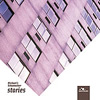Michael J. Schumacher, "Stories"
 Schumacher is an artist for whom the passage between sound installation, performance pieces, and isolated recorded works has been an increasingly fluid process. His first release since last year's lauded Room Pieces, Stories covers much of the same thematic ground, confusing concepts of atmospheric, incidental sound "events" with the markers of a scripted, real-time performance. Here, Schumacher's interest is an exploration of the narrative urges latent in musical composition and the expansion of these urges, as both the context in which a piece emerges, and the way a piece is constructed, are shown to be fragmented, multifarious.
Schumacher is an artist for whom the passage between sound installation, performance pieces, and isolated recorded works has been an increasingly fluid process. His first release since last year's lauded Room Pieces, Stories covers much of the same thematic ground, confusing concepts of atmospheric, incidental sound "events" with the markers of a scripted, real-time performance. Here, Schumacher's interest is an exploration of the narrative urges latent in musical composition and the expansion of these urges, as both the context in which a piece emerges, and the way a piece is constructed, are shown to be fragmented, multifarious.
Making the artist's job easier is a new lushness, previously unavailable in his music and not the result of an increased density of the stereo field but, rather, of an exploded range of sounds. String and horn sections, multiple percussionists, vocalists, guitarists, even a bass clarinetist join Schumacher's typically synthesized piano and guitar mastery, all to be subsumed, like most of Room Pieces, by a computer's "random" fragmentation and regeneration functions. The results are four lengthy fields or towers (to use the cover's analogy) of sounds, grouped at a staggered, stuttered, and loosely over-lapping pace. The true randomness of the pieces' construction becomes doubtful as bits of playing or tone color get accentuated and repeated to establish the relationships responsible for any kind of "story" that develops. The computer's presence does allow for a juxtaposition of context, however, in that it submits a reorganization or restructuring of real-time, often improvised instrumentation. Also, the machine's flattening-out and stratification of such a large, presumably interactive ensemble of musicians removes traces of any original intent, player dynamics, or acoustic relationship within a performed piece. Narrative is not developed explicitly through the additive layering process (nearly obscured by so much digital splicing) but through a series of abstract visitations: chirping, sunny static augmented by the sound of a violin struggling to get up; a synthetic tap-drip turning to labored footsteps, then to a guitar's white noise drawl; Schumacher's stately piano intoning over dim hospital noise, a fake heart's pulse. The cast of story-tellers produce a kind of flowery, electrical ambience that reminds me Tod Dockstader's early work or recent pieces by Olivia Block. The same buzzing, life-seeking atmosphere fills Schumacher's rooms and creates, in shuffled panoramic, his stories. There is something that feels melancholic or even a little old-fashioned about the moodiest moments here, constructs of disembodied female croons, floated piano chords, distant radiophonic voices, and disappearing drones. I feel as if wandering a lost city corner, among half-abandoned high-rises and century-old shacks, their inhabitants and technology ringing in a song of life and existence where no story rises above the rest, and hidden stories of the past speak out. Schumacher's compositions are like electric bubbles of experience, fused in molecular netting and thick in the air of any room. To witness such music in an installation setting might even be harmful, producing only sensory overload or a reluctant linkage to visual media. Regardless, Stories is an example of Schumacher's talent as telling as any I've heard, a strong addition to the catalogs of both artist and label.
samples:



